David Peterson
Heading into 2024, the New York Mets made it clear they weren’t rebuilding. It was a retooling. Even in that reset, they expected to make the postseason.
The decision made sense. They were paying for contracts like Max Scherzer and Justin Verlander. There were young players they needed to get a real look at the Major League level to see if they were part of the future.
Even if the Mets did not make the postseason, the 2024 season should’ve been considered successful because they found out a lot about their team.
Brett Baty wasn’t the third baseman of the present, and now, he won’t be the third baseman of the future. Thats fine because Mark Vientos was, and he was the best hitter at the position at the Major League level.
David Peterson finally emerged to be the starter the Mets thought he could be. Jose Butto and Dedniel Núñez emerged as very good relievers.
Even though he needed Tommy John and will be lost for 2025, Christian Scott looks like a real rotation piece in the future.
That’s similar to what happened to Ronny Mauricio. He went from 2024 second baseman to a man potentially without a spot. For the Mets, they saw something in him and have interest to see if it’s still there.
Speaking of second base, Luisangel Acuña helped save the Mets season when Francisco Lindor injured his back. Is he the Opening Day second baseman? He did enough to put himself in the mix.
Of course, Acuña has defensive versatility. He could be in the mix at center or third depending on a number of Mets offseason moves. He’s not the only player with defensive versatility.
Jett Williams is the Mets best prospect. He could be the second baseman, shortstop, or center fielder of the future. He might’ve gotten a look last year if not for injuries, and we may well see him in 2025.
The same can be said for Drew Gilbert. He was arguably the prize of the 2023 trade deadline. If not for injuries, he might’ve been up last year.
He’s one of several knocking on the door at Syracuse. Dom Hamel, Blade Tidwell, and Mike Vasil are awaiting their chances to see if they’re the next Butto or Peterson.
That’s nothing to say of the Double-A talent. For years, the Mets kept trying to draft Brandon Sproat, and when they finally got him, we all saw why they desperately wanted him. His battery mate, Kevin Parada, has struggled, but you never know when he finally figures it out.
There is a lot of young talent here waiting to help lead the Mets like we just saw Vientos do. That makes David Stearns job all the more challenging.
Who is the player you trade to try to get that big pitcher like Garrett Crochet? Who is untouchable? Who do you try at all costs not to block at the Major League level?
Certainly, none of these players impact the decisions on Juan Soto or bringing Pete Alonso back. However, there are other quality free agents out there who could forever block a Gilbert or a Vasil.
When making those decision, the Mets better be right. This is why this is still a retool and reset than need to go all-in.
The Mets already have enough. There is so much on the way. They don’t need a lot of help. They just need the right help.
Good on the New York Mets players for making the decision hard for the front office. What once looked like a team that would be sellers is now a team who is in Wild Card position.
Certainly, the players don’t want to waste this opportunity. Francisco Lindor and Brandon Nimmo have already publicly put pressure on the front office to be buyers.
However, this is David Stearns at the helm, and he’s cut different. He looks to sustainable winners, not one-and-done teams. Remember, this is the same person who traded Josh Hader when the Milwaukee Brewers were in first place.
Looking at the Mets, they’re on the precipice of building that sustainable winner. They have starting pitching prospects less than three years away. They have position player talent closer than that.
The question for this organization is do they sacrifice the future for this year. Of course, it’s a balancing act. Certainly, the Mets can be on the alert for more Phil Maton type deals. However, the real difference making players come at a real cost.
There’s an argument for an alternative path. That path has been forged already by José Buttó.
For his part, Buttó had struggled in his early Major League starts. He was far better this year, and eventually, partially out of necessity, he was moved to the Major League bullpen.
As a reliever, he is 3-0 with one save and a 0.84 ERA. With him and Maton, the Mets have two reliable arms in front of Edwin Díaz. Obviously, a team with a 4.07 FIP, the tenth worst in the majors, needs more help.
If the Mets aren’t inclined to trade off top prospects to do that, maybe they should be using those top prospects in 2024.
Again, Buttó’s move there has paid dividends. There’s a chance Tylor Megill can help there. Looking at David Peterson, his experience out of the pen last year appears to be helping him as a starter this year.
It’s something we have seen work against the Mets in the past. No one needs to be reminded of Adam Wainwright striking out Carlos Beltran to end the 2006 NLCS.
Keep in mind, Wainwright was struggling in Triple-A with the Cardinals. He had a 4.64 Triple-A ERA. He proved to be a better Major Leaguer.
At the moment, the Mets have a trio of struggling starting pitching prospects in Triple-A: Dom Hamel, Blade Tidwell, and Mike Vasil. Looking forward, Hamel and Vasil will need to be added to the 40 man roster before the 2024 Rule 5 Draft this offseason.
Rather than trade these players (or others), why not give them a look in the bullpen. Let’s see Hamel’s high spin rates fool batters. Tidwell’s fastball/slider combination appears ready for a MLB bullpen now. Let’s get Vasil away from the ABS system.
Let’s see what these young arms can do now. We’ve seen teams do this all the time to help them win. For that matter, Stearns did that in Milwaukee with Corbin Burnes, Freddy Peralta, and Brandon Woodruff.
Stearns knows how to execute this plan. He knows how to take starting pitching prospects and move them to the bullpen with an eye towards eventually using them as Major League starters here.
The plan makes sense for the Mets in the short term. It could payoff in the long term. Perhaps, this is the way to improve the Mets bullpen now while working to develop their top prospects.
The New York Mets were always in a predicament with Seth Lugo. Lugo wanted to start, but he proved to be far too valuable of a reliever. In fact, there was a time you could argue he was the best reliever in all of baseball.
With the Mets controlling his rights for years, Lugo had to sit and wait for his chance to start again. He got that with the San Diego Padres. He signed a one year deal worth $7.5 million with a $7.5 million option for 2024, which he turned down.
Lugo bet on himself, and he won the bet. In 26 starts, he was 8-7 with a 3.57 ERA, 1.203 WHIP, 2.2 BB/9, and an 8.6 K/9. He averaged 5.2 innings per start. He failed to pitch five innings four times, and he came within one out of having a complete game in his last start of the season.
From an advanced stats perspective, he had a 1.8 WAR, 115 ERA+, and a 3.83 FIP. Per Baseball Savant, his fastball was great, and his curveball spin rate remained off the charts. By and large, he was a very effective pitcher.
Digging deeper, we saw he had a .298 BABIP. That’s right in line with career averages and with league averages, so we should not anticipate regression. The same goes for his LOB%. In essence, with Lugo, with the possible exception of age, we should not see regression.
We also know Lugo has the ability to pitch in New York. He arrived in 2016, and he was great down the stretch for a team that made a near miracle run to the postseason. He pitched three days in the row for the first time in his career in the 2022 Wild Card Series, and he was again fantastic.
The moment and the market does not overwhelm Lugo. Rather, he thrives in those situations. That is always of the utmost importance for the Mets.
That goes double for a Mets team looking to rebuild their rotation. So far, they only have Kodai Senga and José Quintana lined up for the rotation next year while they debate what to do with David Peterson and Tylor Megill.
The Mets need dependable starters and pitching depth. Bringing Lugo back does that. If he had enough innings to qualify, he would have ranked in the top 25 in FIP making him a top of the rotation starter in this league. Ideally, the Mets would be bringing him aboard to pitch at the back-end thereby further strengthening their rotation.
When we look forward, Lugo can then be redeployed in the bullpen come the postseason. With that, you get the best of both worlds. You get Lugo being an effective starter, and then you get to see him pull off what Andrew Miller did in 2016. Put another way, Lugo significantly strengthens the Mets chances of winning the World Series.
In the end, there may be better options available. Lugo may want to look elsewhere. However, in the end bringing Lugo back to start for the Mets advances their chances of winning a World Series more than many of the other starters on the free agent market.
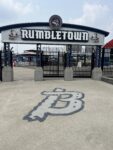
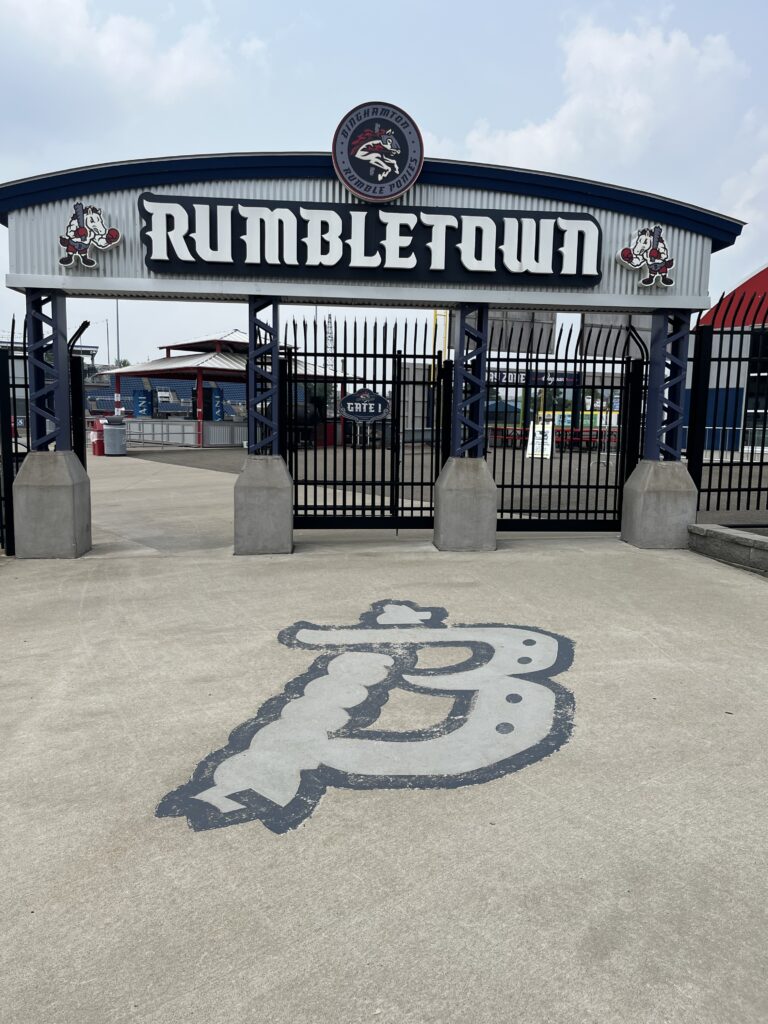
Being a hockey dad means you’re traveling a lot and going/passing through places you may not normally travel. While you may be tired and want to go home after a tournament, sometimes it’s well worth making stops along the way.
Being the avid New York Mets fan I am, my family opted to stop in Binghamton. It made sense as a stop to stretch, eat, and of course, take in Mirabito Stadium.
One thing to know right off the bat is it’s pronounced MER-AH-BIT-TO. A local quickly corrected me when I mispronounced it.
More importantly, the ballpark is open everyday. I found that out when I mentioned to a security guard that I owned this site and was an editor at MMN and I was hoping to walk around the park. His response was, “Okay, well, everyone can walk around as long as they stay off the field.”
Right off the bat, the ballpark has that minor league feel we lose somewhat with the Brooklyn Cyclones. There’s not a bad seat in the house, and you’re right there for all of the action.
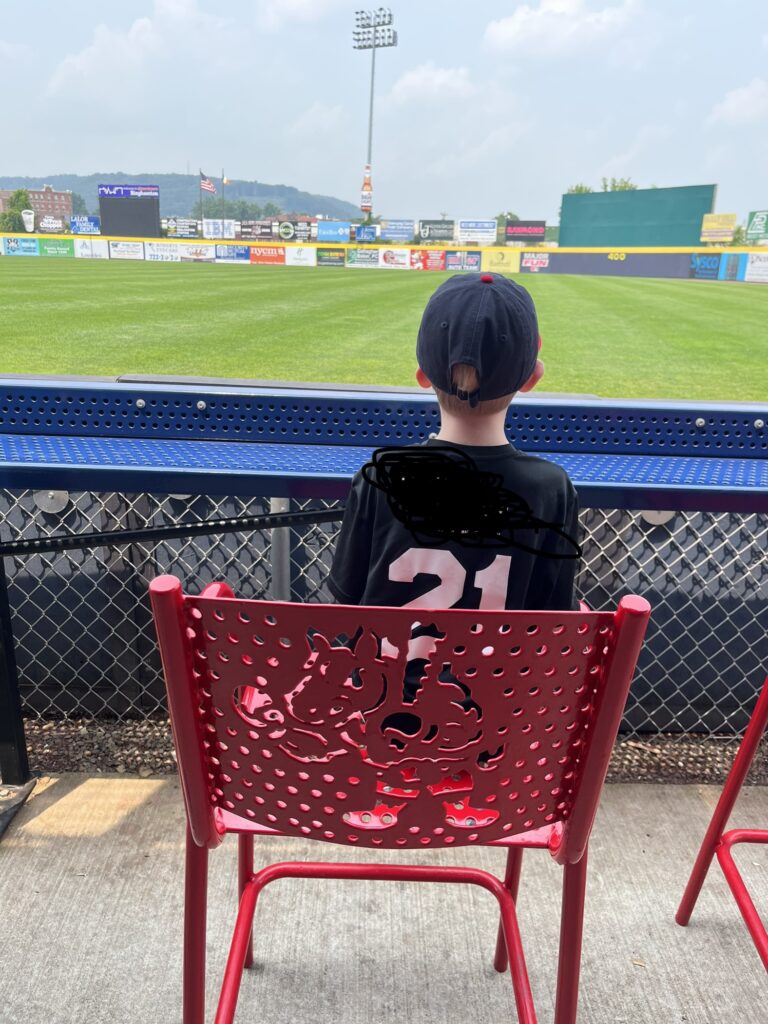
Rowdy the Rumble Pony on the outfield high top chairs was a nice touch. A nice touch describes much of the ballpark which embraces its own history as well as their affiliation with the Mets.
The bullpen carries the monitor “The Road to Queens Runs through Rumbletown.” That was certainly true for current Mets pitchers Grant Hartwig, David Peterson, and Drew Smith. It may also hold true for current Rumble Ponies like Christian Scott and Dominic Hamel.
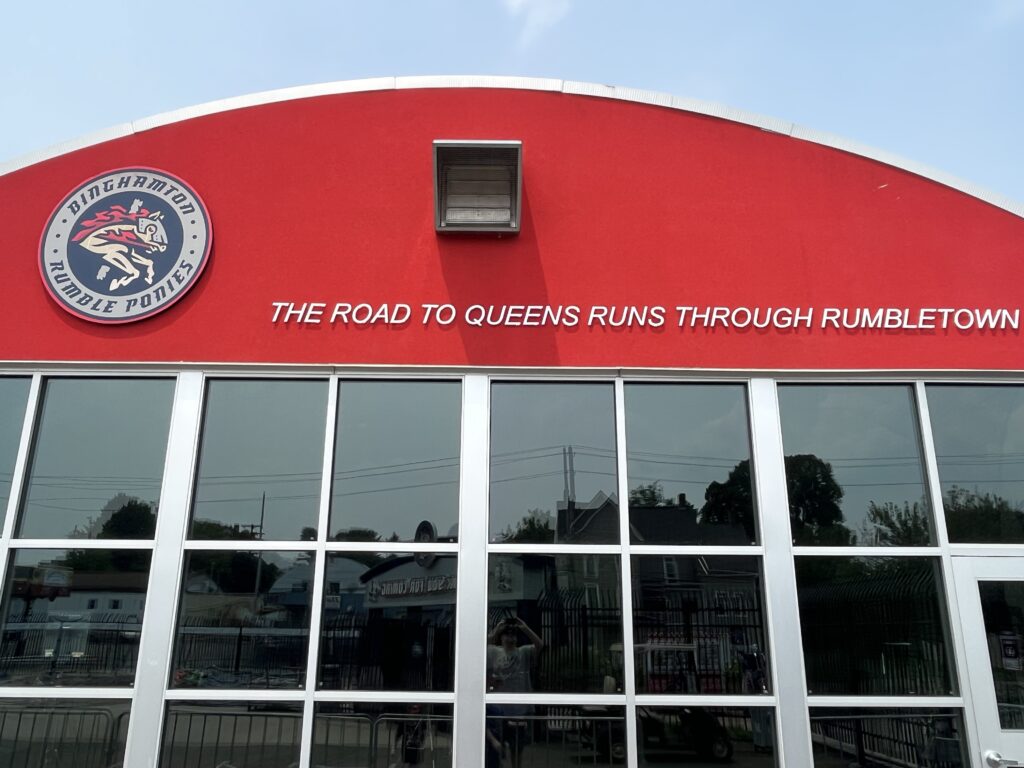
In terms of the history, Binghamton has a “Binghamton Baseball Shrine” honoring all the Binghamton players of yesteryear. It’s there you are reminded Binghamton hasn’t always been a Mets affiliate.
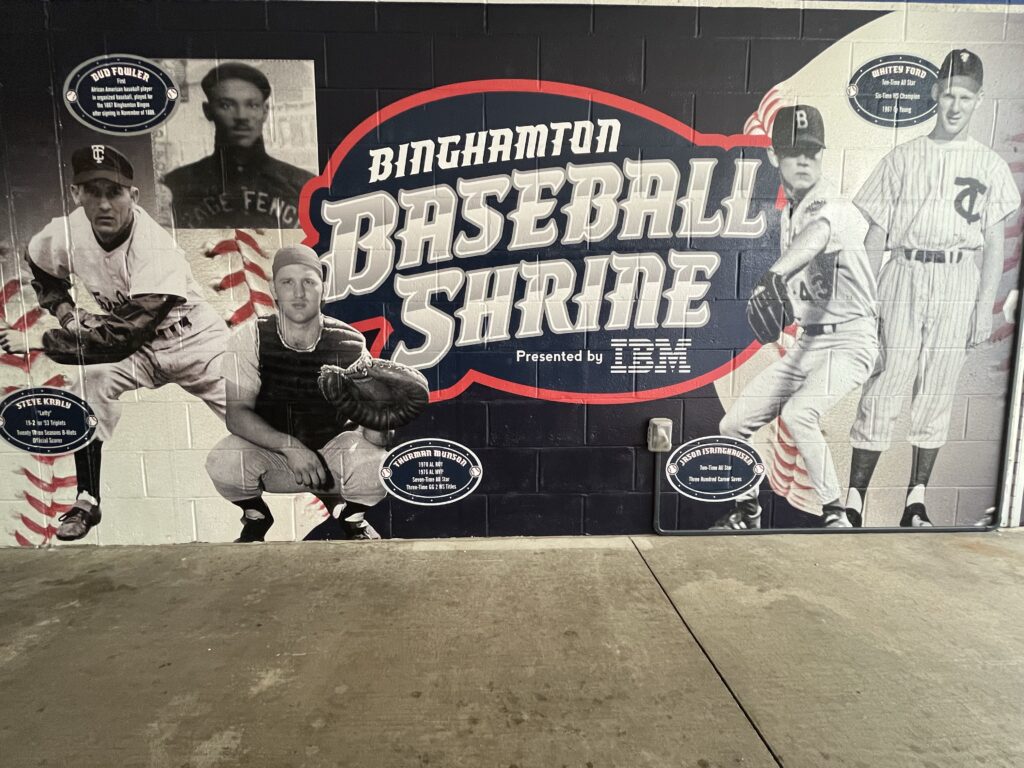
As you can see, most of the players were before the Mets even existed. You see names like Whitey Ford and Thurmon Munson. You can see the Mets feel and acknowledgement with Jason Isringhausen on the far right.
For those wondering where David Wright is, don’t worry, he’s there. He just couldn’t make the main image and is instead off to the side on the door.
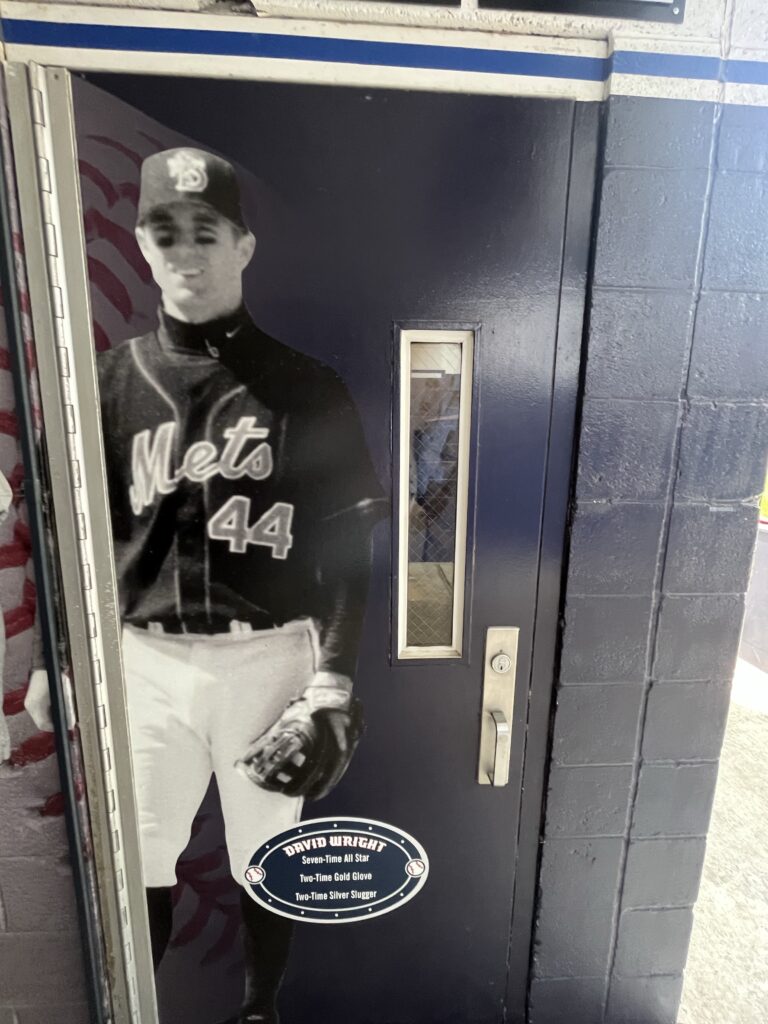
As odd as it was seeing him off to the side, it was even stranger seeing him with the number 44. For those that remember, Wright wanted to wear 4 (he didn’t ask for it) until Charlie Samuel decided Wright should wear 5 for Brooks Robinson and George Brett.
Shockingly, Samuel didn’t remember Robin Ventura of Grand Slam Single Fame. But, I digress.
Unfortunately, the Baseball Shrine is out of the main view, but it is en route to the gift shop. On the way, you will also see things like the lineups and league leaders (Eastern League and MLB).
The gift shop has what you’re really looking for with hats, jerseys, cards, and of course, stuffed animal mascots. You can get the jerseys personalized (but not t-shirts). It’s all reasonably priced with discounted winter items. I walked away with a cap.
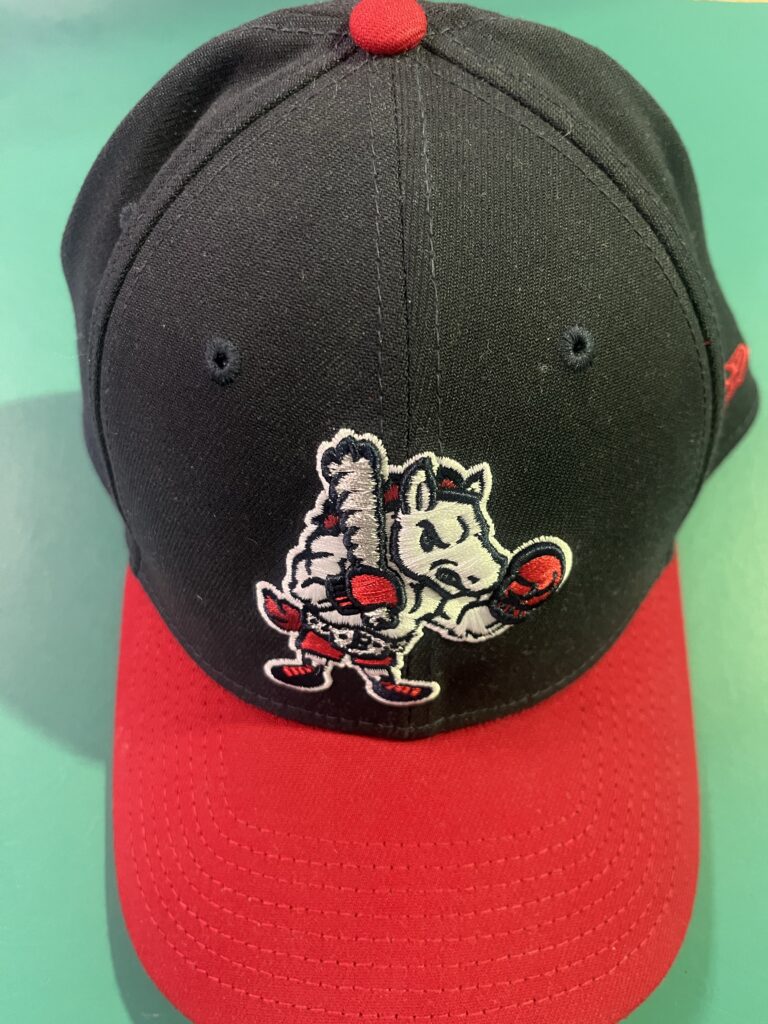
The only downside of the trip to the ballpark was it was not a game day. That said, the staff was great, and my kids had a blast running through the park. Certainly, there will be a trip back to Binghamton to catch a game or two.
Just when you got good vibes going with the New York Mets winning six in a row to open July, they enter the All Star Break losing two in a row. The Saturday loss wasn’t that bad as you knew it was going to be a tough game.
The Mets started David Peterson, who battled and kept the Mets in the game. They had Pete Alonso and Francisco Alvarez up as the tying run in the ninth, but Josh Hader was better. You tip your cap and move onto the next game.
The next game was the real problem.
After what seemed like a resurgence, Max Scherzer again wasn’t good. The struggling Manny Machado tagged him with a three run homer in the first inning. This wouldn’t prove to be one of those get the ace early because he’ll shut you down moments because Machado would hit a two run homer against Scherzer in the fifth.
The Mets offense sputtered, and this time Joe Musgrove didn’t need an oil slick on his ears to do it.
Tommy Pham went down with an injury. Buck Showalter made sure to bat one of his old Baltimore Orioles, DJ Stewart, above Alvarez and Brett Baty. Really, no one was particularly good on the day, and Brandon Nimmo continues to be mired in an 0-for-20 stretch. He’s also 3-for-30 in July.
To a certain extent, these last two games might have caused fans needless hand-wringing. We did get a little excited with the winning streak, especially with it coming against good teams. We thought there might be a glimmer of hope that the Mets were getting back into the race. With the way the starting pitching was going, there was good reason for it.
As it stands now, the Mets are 18.5 games back of the Atlanta Braves. They are also seven games back in the Wild Card. They trail five teams for that last Wild Card spot including the San Diego Padres who leaped ahead of the Mets after this series.
It’s too much to say this series ended the season. After all, their putrid June probably did that. Rather, this might’ve just been another nail in the coffin. No, it’s not over, and we have seen stranger things happen (1973, 2016). However, it is a series like this that should have us temper our expectations until further notice.
The New York Mets finally broke glass for emergency and called up Mark Vientos from Triple-A Syracuse. The move was needed after the Mets went 56 innings without a homer, and the team dropped to three games under .500.
VIentos is not going to fix all that ails that Mets. After all, he can’t help José Quintana heal faster. He can’t get Max Scherzer and Justin Verlander to rewind the clock a year. He can’t get David Peterson to rediscover his ability to pitch.
All Vientos can do is go out there and hit. Even on a team with Pete Alonso, Vientos could possibly be the Mets best power bat at the moment. So far this year, he has a 169 wRC+ and 1.104 OPS with Triple-A Syracuse. He has also posted historically higher exit velocities than Alonso did in the minors.
Of course, none of that is here or there. Mostly, it just highlights how the Mets have two very similar power bats in the lineup in Alonso and Vientos. Of course, the Mets can only take advantage of that by actually playing Vientos.
Mark Vientos with his 13th HR of the season.
107.2 mph off the bat and traveled 411 feet.
— Mathew Brownstein (@MBrownstein89) May 17, 2023
So far this season, we have seen Buck Showalter reticent to play his younger players and/or give them more responsibility. When Brett Baty was called up, he started in a platoon. When Francisco Álvarez was called up, he was named the back-up catcher, and even after winning the job from Tomás Nido, he still can’t get above hitting ninth in the lineup.
With Vientos, the Mets already have Daniel Vogelbach as the DH. Showalter does not like playing rookies over veterans, and it is going to be difficult to do that with Vogelbach with him being productive with a 119 wRC+.
That said, Vogelbach has been slumping, and he has not come close to posting the power numbers expected from a DH. More to the point, Vogelbach is not capable of providing the damage at the plate Vientos potentially can.
Certainly, there will be the impetus to make Vientos a platoon option with Vogelbach usurping the role Tommy Pham was supposed to have. Notably, Vientos struggled in that platoon role last season, and you have to believe Showalter remembers those struggles.
To his credit, Vientos has been better for those struggles. He has significantly cut down on his strike out rate. With his making more contact, he is destroying baseballs in Triple-A. He promises to add a dynamic to the Mets offense they sorely need.
However, that only works if he actually plays. That does not mean a platoon at third with Baty. It does not mean a platoon at DH with Vogelbach. It means in the lineup everyday. That is the expectation, but we will see if that is the plan Showalter has.
In 2022, we saw a glimpse of what David Peterson could be as a starter for the New York Mets. Seeing that pitcher, the Mets cannot just give up on him as a starter. However, that does not mean they’re obligated to let him figure things out at the Major League level.
Through eight starts, Peterson is 1-6 with an 8.08 ERA, 1.744 WHIP, 3.2 BB/9, and a 10.4 K/9. The advanced statistics don’t provide much more promise either with Peterson having a 52 ERA+ and a 4.82 FIP.
At Baseball Savant, we see Peterson has a decent whiff rate and an excellent extension. However, that is just about all he is doing well with batters squaring him up easily and he’s getting little to no spin on his pitches.
His slider remains an effective weapon getting a 35.6 Whiff%. However, that is a steep drop-off from the 45.0% it was last year. With Peterson’s fastball being flat and hit hard, he can ill-afford the slider not being as elite as it was last season.
Part of the issue may be pitch mix with Peterson throwing fewer sliders and more change-ups and sinkers. The change has been effective pitch, so you understand the increased usage. However, for two years running, Peterson’s sinker gets mauled. At some point, he is just going to have to scrap that pitch because it is completely ineffective at the Major League level.
Between the pitch mix and whatever else is ailing Peterson, he has not been the pitcher he was last season. We see that being one of the driving forces in what has been a disappointing start to the Mets season.
Through his first eight starts (and two relief appearances) last season, Peterson was 4-1 with a 3.18 ERA, 1.346 WHIP, 4.4 BB/9, and a 8.3 K/9. Over that stretch, his FIP was 3.91. This is a completely different pitcher. He was one who gave the Mets a chance to win.
The Peterson we see this season is not giving the Mets much of a chance to win. With the Mets lineup devoid of power, they don’t have the chance to win games or even be competitive.
This leaves the Mets with few good options. Maybe, they need to give José Butto more of a look until Carlos Carrasco comes off the IL. At least, Butto has been more competitive. Again, it may not be the best option, but it is a better one at the moment.
Whatever the plan, the Mets are going to need the Peterson we saw in 2022 at some point this season. It is better to get him to Syracuse now to have him figure it out because right now it is just not working, and the Mets don’t have the bats to let him figure it out.
The New York Mets were swept in a doubleheader by the Detroit Tigers. With the Tigers being a very bad team (entered the day 10-17), that’s bad news in and of itself, but it’s not quite cause to overreact.
Losing with Adam Ottavino blowing the save in game one is what it is. Ottavino hasn’t quite been what he was last season, and this is the second time out of five chances he has faltered in ninth inning duties. Considering he had a 2.70 ERA before the appearance, this is not cause for alarm.
No, the real cause for alarm was Max Scherzer was very bad . . . again.
In a homecoming of sorts, Scherzer lasted just 3.1 innings allowing six earned on eight hits and one walk. He only struck out three. He allowed two homers. There’s no other way to say it. He was horrible.
More to the point, he has been very bad this season. He’s averaging 4.2 innings per start. Yes, that is partially because of the 10 game suspension, but he also has not pitched beyond 5.1 innings since his Opening Day start.
The 7.9 K/9 stands to be the worst mark of his career. The same goes for the 20.8 K%. His 2.00 K/BB and 2.4 HR/9 also stand to be the worst. Really, all across the board, this looks like it is going to be the worst season of Scherzer’s career.
With Scherzer being 38, this is cause for panic. He is supposed to be a co-ace, and instead, he looks like a pitcher who could be done. He’s not even pitching like an effective fifth starter.
Maybe it was the altered off-season routine because of last season’s oblique issues. Perhaps, it is the pitch clock. Maybe, just maybe, it is the fact, he’s 38 years old, and sooner or later, we were just going to see his performance drop.
Scherzer thinks the layoff hurt him. Maybe, he’s right, but then again, he seemingly has had a lot of excuses this season. He’s needed them too with his performance.
His fastball velocity is down almost a full MPH with it dropping to 92.5 MPH in the start against the Tigers. The average exit velocity against us by more than three MPH. The hard hit rate is a troubling 40.9%. Batters have been able to barrel him up.
Looking at the spin rates in his first start back from the suspension, they were all notably down. That’s not de facto evidence of cheating or a drop off. It could just be frustration and confusion on what to do now after being suspended for using rosin. Remember, David Cone effectively defended Scherzer on Sunday Night Baseball.
The cheating or not aspect misses the point. If Scherzer is now at a loss for what he can and cannot do, we should be at a loss for how Scherzer reclaims his ace form.
The Mets are missing José Quintana. Carlos Carrasco looked done before going on the IL. David Peterson regressed. Tylor Megill hasn’t lit the world on fire. Joey Lucchesi followed a great start against the San Francisco Giants with diminishing returns in his subsequent starts.
This Mets team was built on their starting pitching. Considering they did not improve the offense, their chances of contending are tied to this rotation. Even if Justin Verlander is what we hoped he would be, it looks like the rotation as a whole won’t be. If that’s the case, the Mets are in a very dangerous place.